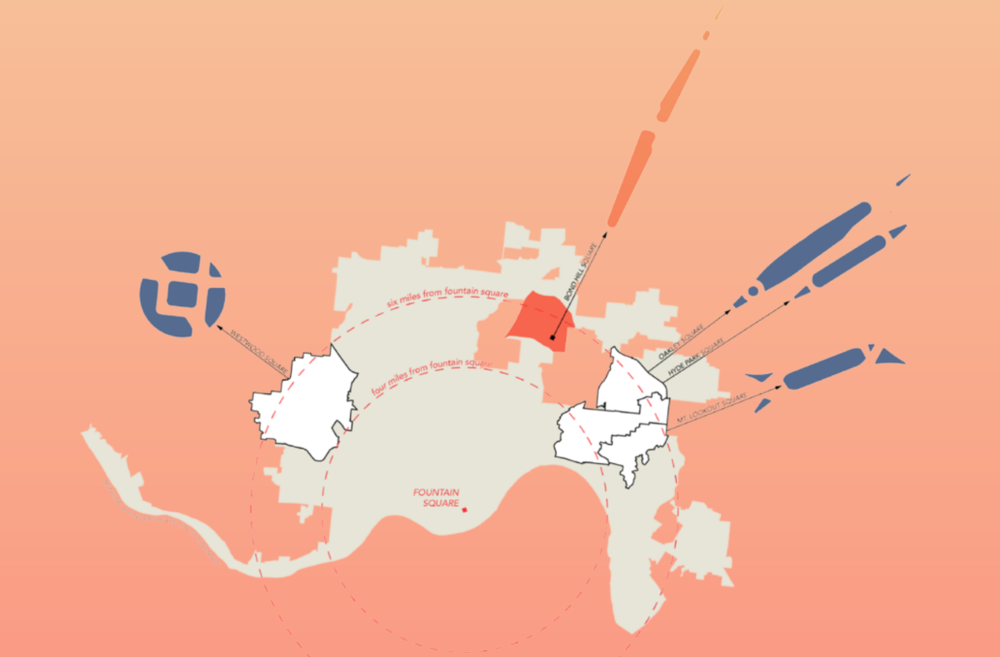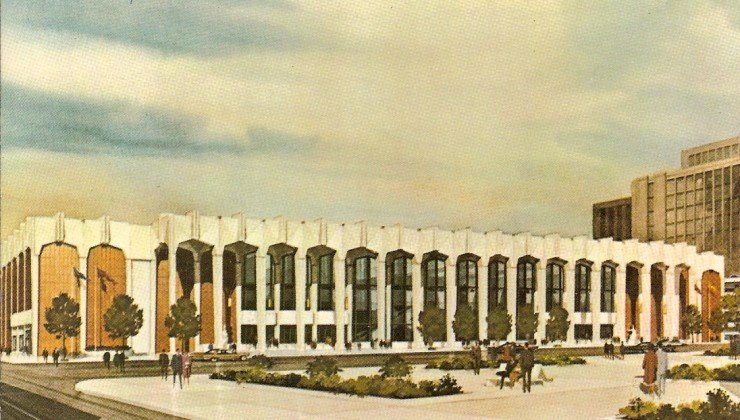Everything posted by Chas Wiederhold
-
Cincinnati: CUF / Corryville: Development and News
They were so close to being unnoticeable, forgettable, and meh, but then they slap on a poorly proportioned vinyl cornice and transform into annoying, cheap, and distracting. While I doubt this is in a historic district this is almost exactly what the Cincinnati Historic Guidelines ask for: Base, Middle, Top. Ordered windows. Conservative materials. This building is an example of why those guidelines are dangerous: this building could pass and HCB hearing and get built in OTR.
-
Cincinnati: Random Development and News
Glendale is pretty great. I've got family there (shout out to my fam who lurks this board) and the bike ride to them takes you through Elmwood Place, St. Bernard, and Wyoming. Bluebird Bakery, some good shops for last minute gifts (if I'm heading to a family party, this comes in handy), Cock & Bull, and a few other places if you go a block into the village.
-
Cincinnati: Random Development and News
Thanks for pulling together my Saturday morning bike ride list for this summer.
-
Cincinnati: West End: TQL Stadium
^Substantiate any of this^ FCC put the cart before the horse and now the city and the residents have a powerful upper hand. They did things out of order, weren't patient enough to go through the required processes, and they made a mistake because they thought they were above the law. Hubris.
- Cincinnati: West End: TQL Stadium
-
Cincinnati: Random Development and News
I wouldn't be so sure about Elmwood going the Cincinnati-way before it was annexed by St. Bernard. They do share a school district and they are building a new consolidated preK-12 as we speak.
-
Cincinnati: Random Development and News
I remember reading somewhere (maybe in the must-read for Cincinnatians, "Contested Ground") That Lincoln Heights had claimed land that would have provided the historically black community with an industrial tax base that just about everyone in the area agreed was "in Lincoln Heights" but the *trigger warning* racist white-supremacist county government "disagreed" and that land was determined to be within the boundary of Evendale or something.
-
Cincinnati: Random Development and News
While I don't disagree with you, somehow St. Bernard is able to do this. All that tax revenue from P&G's campus?
-
Newport, KY: Ovation
Music is a hobby.
-
Cincinnati: Random Development and News
APPROPRIATE I agree, I disagree. I don't think we need to put all of Norwood in one bucket... but let's compare it to another enclave, St. Bernard, where the whole place is walkability oriented. If St. Bernard were in the City of Cincinnati, I would definitely consider it as a place to live/buy a house. It's also a working class city, is it not? Is it being gentrified?
-
Newport, KY: Ovation
I like Cleveland, and have had an incredible experience every time I've gone, so I just want to hop on its defense BUUUUUUT When I attended the Cincinnati Preservation Association Luncheon last year the highly decorated Terry Stewart, former director of the Rock and Roll Hall of Fame, said that he felt like the RaRHoF could have just as sensibly be built in Cincinnati as it was in Cleveland. I don't remember his exact words, but everyone left sort of shocked with how boldly he stated that Cincinnati contributed just as much, maybe even more, to rock and roll culture as Cleveland. All of this to say as much people were averse to Laurie Quinlivan's "City the Sings" thing... it really is a city that appreciates music and I'm excited to have more venues in town.
-
Cincinnati: Random Development and News
I think part of the phenomenon here is that upwardly mobile white folks (me for example, having grown up in Appalachian Brown County and attended high school in Clinton County because Wilmington had more resources and cultural institutions) can "other" poverty as being separate from impacting them, their families, or people like them by gentrifying a neighborhood of people who don't look like them. If an upwardly mobile white person were to live in, let's say, Lower Price Hill, they would have to confront the fact that poor people are white too. You already know the factoid, "White people make up the largest share of food stamps and Medicaid recipients, but as a share of the U.S. population, they utilize proportionally less than other groups." Living in Lower Price Hill, an upwardly mobile white person would be confronted with this every day. Living in a black or Hispanic community, they can distance themselves from that reality. Love it or hate it, "Hillbilly Elegy" covers a lot of this ground. It also can't go without saying that many of these terms, white, black, hispanic, latinx, hillbilly, etc all are loaded terms that in this conversation are being used without a norm or common ground of use rooted in any sociological framework. Instead of "White People," when I can I like to use Ta'Nahesi Coates' phrase, "people who believe they are white" because it refers to a pre-assimilated world where Catholics, Germans, Irish, Italians, etc were also all "othered" by a dominant WASP-identifying American culture.
-
Cincinnati: Random Development and News
That might be fun to say, but it isn't entirely true. A lot of young, educated, creative folks are moving into the neighborhood. Anecdotally, I've had several friends, most of them couples, move to the neighborhood and buy their first homes. Some are even purchasing duplexes and renting them out to other families. East Price Hill is becoming more diverse, not just in skin tone but also economically. More than anything, I believe it is the West Siders' inability to see that their grandparents' homes are worth investing in that is creating this niche in the market.
-
Cincinnati: Random Development and News
That is beginning to change. While the population in Price Hill is more Guatemalan than Mexican, several new events and venues are celebrating Central American culture. The St. Lawrence Square concert series put on by Price Hill Will features Armadura Musical and Salsaires Cincinnati. Vera Cruz restaurant has opened on Price Ave. Santa Maria, one of the oldest social services in the city, operates Literacy Center West, which is completely bilingual. There is a Mayan inspired mural across the street from MYCincinnati's current facility on Warsaw. The Kroger on Warsaw has the widest selection of Central American cuisine that I've ever seen in a Kroger. La Viña church uses Roberts Academy library for their services (that may have changed... I haven't worked there since July 2014). And the Catholic schools are nearing 50% latinx. I'm interested to see what the census results show following next year's count but I'm also worried that Trump's intimidation measures may keep some people from filling out the forms.
-
Cincinnati: Random Development and News
The interesting thing about immigrant succession in Cincinnati today is the pathway folks take once they get to the city. For Central American immigrants, they often settle first in Lower Price Hill. The absolute cheapest place to live. They then move up to East Price Hill once they reach a certain level of economic mobility. Following that they move to Springdale, Fairfield, and Hamilton. It's a really interesting flow. Not that this article mentioned it, but Catholic Charities of Southwest Ohio is a participant in this resettling. They also settle many of the West African families in the area as well. Again, often landing first in Lower or East Price Hill, and then moving along Queen City, and further west. I spent a year of AmeriCorps service working for Santa Maria Community Services' Immigration Welcome Center, which at the time was HQed at Robert's Academy. These folks are working their tails off and I think Cincinnati is lucky to have them here now.
-
Newport, KY: Ovation
-
Cincinnati: Fountain Square: Development and News
It might look nice in photos in the middle of the street, but I don't think you'd find folks hanging out, eating chipolte, or salsa dancing on a Thursday night in the early version of the square unless it was more shaded and a bit wider. As for the "is a square a square if its not square" question: none of the "squares" in Cincinnati would ever really qualify as squares to someone who paid attention in geometry class. Hyde Park, Mt. Lookout, Oakley... even when Westwood was planning theirs, it was more rectangular. The Cincinnati Square is a cultural term... and it more likely means "a place given back to public parks after market and streetcar functions have ceased" lol Last year, I was on a team competing in the local ULI competition proposing a "square" and surrounding development for Bond Hill. Justified by looking at the radius from Fountain Square that the aforementioned squares were and suggesting that a "square" in Bond Hill would catalyze development along Reading. Our "square," as well, was not square but more boomerang shaped. You can see the presentation here with our argument outlined: https://drive.google.com/open?id=0B_XiOUYWPKtITkYwSXVaUEJFNHNKOWpYa0w4YlJ4N21hWE5j For what its worth (and despite my best efforts to be humble, I can't resist sharing) we won the $5000 prize.
-
Cincinnati: Downtown: Convention Center / Hotel
As advocates for urbanity and the built environment (big assumption about the people here on UO) we can either perpetuate the cycle of buildings thought to be ugly by a vocal group of people connected to the power of the bulldozer, or we could have an attitude that architecture tells a story of a time and a place and for that reason alone, respecting styles from the past is an important ethic to uphold. The opposing view to this is that society didn't really care too too much about historic architecture until the advent of the museum so why should we be active in preserving anything. The museumification of places certainly creates new conflicts that humans haven't really prioritized up until the last 400 years. This isn't my position... I'd rather live in a world that continues to build and repair over time as needed in a sort of urban wabi sabi way.
-
Cincinnati: Downtown: Convention Center / Hotel
@savadams13 is right, I was refering to the Convention Center in my post... meant to say Elm and 5th. Whoops! Corrected.
-
Cincinnati: Downtown: Convention Center / Hotel
A couple things on this: 1) The corner of Elm and 5th is really nice, quality Post-Modern architecture. Noteworthy architecture. If you don't like it, it's because of taste, not because it isn't good. I also don't mean to indicate that anyone has bad taste if they don't appreciate Post-Modern architecture. It has certainly taken a long time for it to grow on me. (I had plenty of professors who used Post-Modern as a derisive critique, which could be the reason why its taken me some time to appreciate it). I also love the billboard Cincinnati on the west side. I think it is something really unique for the city. I just wish there was a giant park or plaza in front of it so you could actually enjoy the sign from anywhere but Price Hill when you aren't in a car. 2) The convention center we see today is not what is has always looked like. The original convention center (not music hall) was built in 1967, I believe. And it looked like the attached. RIP Sweet Brutal Baby. I wish I was alive to see you in person. 3) 6th Street, north of the convention center was a market street. So just like Findlay Market, Court Street, Piatt Park, Fountain Square, Pearl Street and others, 6th Street for the two blocks of the convention center was extra wide. How did car oriented designers of the 20th century respond? Get rid of the public space and expand the Convention Center north.
-
Cincinnati: Over-the-Rhine: Development and News
@jmecklenborg I was walking from Liberty to Kroger on Vine following a couple and their child. Dad was wearing a Titan's hat. Kid said something and Mom says, "We're not in Nashville, Cincinnati is a big city." I have no idea what they were referring to, but I found it very amusing considering how Nashville proper is double the size of Cincinnati, and MSA-wise, Cincinnati is only 200,000 larger.
-
Cincinnati: West End: TQL Stadium
Just my opinion: I think Council is doing the right thing by withholding the zoning approval. It's not like FC Cincinnati is going to stop building their stadium. I haven't thought out what type of precedent a move like this sets, but I think standing up for renters in this situation is a strong moral position.
-
Cincinnati: University of Cincinnati: Development and News
There is a big opportunity with this Clifton Court Building to right a wrong: Create a 4-way intersection at Joselin and Clifton. Change the McMicken Arc so that it hits Clifton at Joselin instead of where it does not, and then have Clifton Court terminate into the newly aligned McMicken Arc. Add crosswalks and medians where turn lanes aren't needed. This stretch of Clifton seems like a hit pedestrian waiting to happen.
-
Cincinnati: CUF / Corryville: Development and News
Loving it. That massing is unique and negotiates its adjacent buildings and Sigma Sigma Commons well. The interior is pretty phenomenal. Soaring spaces, intimate spaces, a ridiculously cantilevered stair in the central atrium, exceptional courtyard. I wish the paneling on the outside of the building was a lighter, warmer grey or white. The rooftop vegetation is precedent setting. There shouldn't be another building built on campus that can't create rooftop ecosystems like this one. It should be a sustainability priority. I like how the building creates a quad between ERC and CRC. I could go on.
-
Cincinnati: Over-the-Rhine: Development and News
Talk to anyone who knows anything about music and they will tell you an acoustically pure space is a treasure and anything but a theater is a waste of that treasure. I don't know enough about music to expand, but those (who do know about music/sound) I've spoken with drool and foam at the mouth when discussing the Emery Theater.







